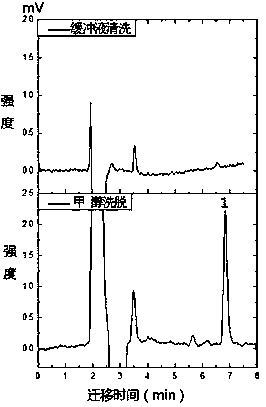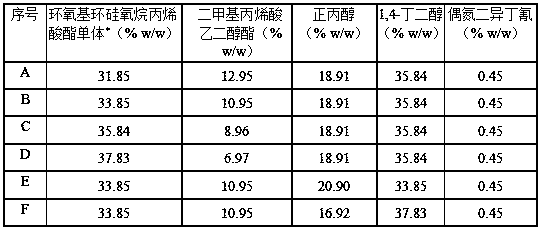An organic polymeric monolithic column that specifically recognizes ochratoxin and its preparation method
A technology for ochratoxin and specific recognition, which is applied in separation methods, chemical instruments and methods, and other chemical processes, and can solve problems such as large material consumption, polar solvent interference, and rigid recognition "holes are easily destroyed or deformed" , to achieve more sites, improve stability, and improve the efficiency of modification and bonding
- Summary
- Abstract
- Description
- Claims
- Application Information
AI Technical Summary
Problems solved by technology
Method used
Image
Examples
Embodiment 1
[0031] An organic polymeric monolithic column that specifically recognizes ochratoxin. The monolithic column first thermally initiates polymerization in an alkenylated capillary with epoxy cyclosiloxane acrylate monomer and acrylate crosslinking agent to form a Highly cross-linked, epoxy-based cyclosiloxane polymerized monolithic column matrix stationary phase with a branched structure of epoxy groups. The ligand is prepared; the surface of the monolithic column stationary phase is bonded with a nucleic acid aptamer that specifically recognizes ochratoxin A.
[0032] Table 1 Contents of different components of epoxy cyclosiloxane acrylate polymerized monolithic stationary phase
[0033]
[0034] * : Epoxy cyclosiloxane acrylate monomer is 2-hydroxy-3-{3-[2,4,6,8-tetramethyl-4,6,8-tri(propyl glycidyl ether)- 2-Cyclotetrasiloxane]propoxy}propylmethacrylate.
[0035] Prepare the capillary monolithic column matrix stationary phase according to the component content table sho...
Embodiment 2
[0043] Apply the base stationary phase of the unmodified nucleic acid aptamer and the epoxy-based hydrolysis stationary phase, and implement according to the following steps: (1) Equilibration: For the monolithic column prepared by formula B, first equilibrate with binding buffer for 1 hour, and the chromatographic conditions are: Flow rate 0.10 mL / min, pressure 250psi, the pH of the binding buffer is 8.00, containing 10mmol / L Tris-HCl, 120 mmol / L NaCl, 5 mmol / L KCl and 20mmol / L CaCl 2 ; (2) Enrichment: Inject 20 microliters of 0.50 μg / mL ochratoxin A (OTA) solution, enrich on the monolithic column for 1 hour, the chromatographic conditions are 0.05 mL / min, pressure 250 psi; (3) Cleaning : Install the enrichment column on the liquid chromatography pump, wash the matrix stationary phase and the epoxy hydrolysis stationary phase of the unmodified nucleic acid aptamer with binding buffer for 14 hours and 10 hours respectively; the elution condition is a flow rate of 0.03 mL / min,...
PUM
 Login to View More
Login to View More Abstract
Description
Claims
Application Information
 Login to View More
Login to View More - R&D
- Intellectual Property
- Life Sciences
- Materials
- Tech Scout
- Unparalleled Data Quality
- Higher Quality Content
- 60% Fewer Hallucinations
Browse by: Latest US Patents, China's latest patents, Technical Efficacy Thesaurus, Application Domain, Technology Topic, Popular Technical Reports.
© 2025 PatSnap. All rights reserved.Legal|Privacy policy|Modern Slavery Act Transparency Statement|Sitemap|About US| Contact US: help@patsnap.com



